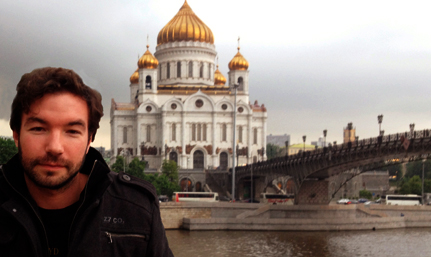 |
Jurie Swart in Moscow.
24 June 2013 |
“I am proud that I could honour the UFS’ name,” says Jurie Swart. He participated in the prestigious Archiprix in Moscow in May 2013.
Archiprix is an international competition where the world’s top architecture students are selected. Architecture departments, schools and faculties of 1 500 universities from 78 countries worldwide are invited to enter their top master’s students over two study years.
In 2012, Jurie Swart was honoured as regional winner of the Corobrik Architectural Student of the Year Award and also received an honourable mention in the 2012 International Graduate Architecture Projects.
After several months of careful evaluation by a panel of five experts, his thesis, Borderline – mediated landscape, A water research centre for the University of the Free State, Qwaqwa Campus, was nominated as one of the world’s 25 master’s projects to take part in the Archiprix in Moscow. His thesis was also on display at the Central House of Artists in Moscow for a couple of months.
The judges were Yuri Grigoryan (architect and director of the Moscow-based Project Meganom, as well as director of educational programmes at the Strelka Institute in Moscow); Susan Herrington (professor of architecture and landscape architecture at the University of British Columbia in Vancouver, Canada); Kristin Jarmund (architect and director of the Norwegian-based Kjark, an architectural house); Hubert Klumpner (architect, director of the Venezuela-based Urban-Think Tank, and professor of architecture and urban design at the ETH, Zürich ); and Lesley Lokko (architect, academic and author from the UK).
Jurie Swart was selected as the participants’ favourite. “From the top 25, seven winners were announced, and although I didn’t win, it is still an amazing achievement and I am proud to have honoured the university’s name,” he said.
During his visit to Moscow, he also attended a workshop with the rest of the nominated students. This project, with the theme Railroads, was an exercise to help solve Russia’s transport problems.